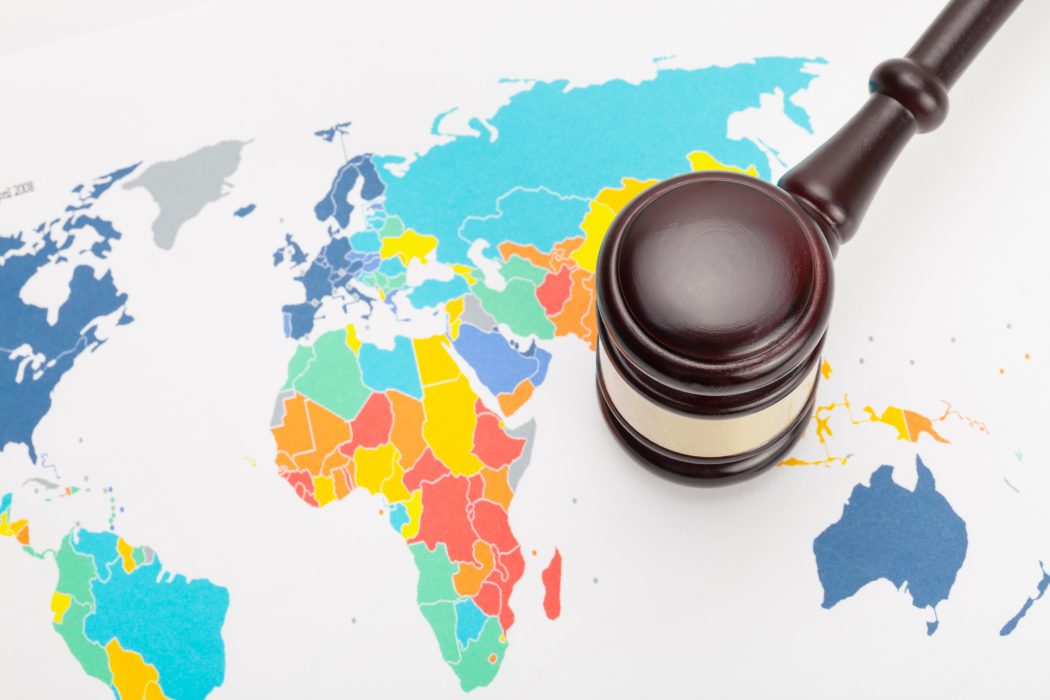The first international agreement aimed at “civilizing” warfare, the Treaty for the Regularization of the War, was signed in 1820. The world has since experienced, among countless other conflicts, two devastating world wars and all of their unimaginable atrocities. The last century has seen various treaties, charters, and conventions take place, yet one would be hard-pressed to find a modern country in existence that hasn’t been accused of violating human rights during conflict. It is important to keep in mind the following point while discussing international laws of combat: they have been broken more often than followed.
International laws of war are divided into two main areas: jus ad bellum and jus in bello.
Jus ad bellum, “right to war” (Lat.), refers to laws pertaining to justifiable use of force and ethically sound military measures. Laws that seek to limit jus ad bellum are ius ad bellum (law on the use of force) or ius contra bellum (law on the prevention of war.)
Jus in bello, “right in war,” is concerned with the conduct of parties already engaged in hostilities, no matter how they got there and who may be the wronged party. It is mostly invested in protecting noncombatants and captives, as well as forbidding unconventional warfare. Jus in bello is also known as international humanitarian law, or IHL.(1)
The Hague Conventions
The Hague regulations (1899 and 1907) form the basis of modern laws of war and are considered binding on modern states today, even though they signed by long-gone European monarchies:
Provisions of these conventions are considered to be part of the rules of customary international law. Today all states, even those that are not State Parties to either or both Conventions, are considered to be bound by their provisions.(2)
The Hague conventions attempt to establish both jus ad bellum and jus in bello boundaries. There are clauses to facilitate peaceful resolution of conflict, to limit the methods that armies may use, and to forbid attacks on civilian targets. One of the 1907 Hague regulations, a jus ad bellum clause, is most relevant to the Six-Day War’s breakout:
The Contracting Powers recognize that hostilities between themselves must not commence without previous and explicit warning, in the form either of a reasoned declaration of war or of an ultimatum with conditional declaration of war.”(3)
Meaning, a war should not begin as a surprise attack, but in a gentlemanly formal challenge.
The Geneva Convention
Based on a series of international meetings from 1862 to 1949, the Geneva Convention lists rights of noncombatants, as well as those pertaining to injured and captive soldiers. Its provisions are concerned with jus in bello rights of individuals once the conflict has commenced, not with initiation of conflict (jus ad bellum) scenarios.(4)
The Geneva Convention becomes more relevant to Israel with a protocol added in 1977 that seems to be, if not a direct response to the situation after the Six-Day War, at least strongly aware of it:
Armed conflicts in which peoples are fighting against colonial domination, alien occupation or racist regimes are to be considered international conflicts.(5)
This distinction is significant. Once recognized as taking part in an international conflict, a detained terrorist becomes a “captive combatant” and is awarded the accompanying rights and privileges, not the least of which is that their treatment is now under a level of international and UN scrutiny that does not exist when a country legally detains its own citizenry.
The UN Charter
The United Nations charter’s very first chapter includes a clause concerning ius contra bellum, a law seeking to prevent war:
All Members shall refrain in their international relations from the threat or use of force against the territorial integrity or political independence of any state, or in any other manner inconsistent with the Purposes of the United Nations.(6)
If a dispute still arises:
The parties to any dispute, the continuance of which is likely to endanger the maintenance of international peace and security, shall, first of all, seek a solution by negotiation, enquiry, mediation, conciliation, arbitration, judicial settlement, resort to regional agencies or arrangements, or other peaceful means of their own choice.(7)
The Charter finally acknowledges a situation when jus ad bellum is possible. It is limited to the most direct, unambiguous, and pressing circumstances of self-defense, precluding preemptive attacks:
Nothing in the present Charter shall impair the inherent right of individual or collective self-defence if an armed attack occurs against a Member of the United Nations, until the Security Council has taken measures necessary to maintain international peace and security. (8)
The reason this path to peaceful resolution is considered possible lies with the creation of the then-brand-new UN Security Council:
Should the parties to a dispute of the nature referred to in Article 33 fail to settle it by the means indicated in that Article, they shall refer it to the Security Council
If the Security Council deems that the continuance of the dispute is in fact likely to endanger the maintenance of international peace and security, it shall decide whether to take action under Article 36 or to recommend such terms of settlement as it may consider appropriate (7)
This council is authorized to use force to protect the nation under attack:
The Security Council may decide what measures not involving the use of armed force are to be employed to give effect to its decisions, and it may call upon the Members of the United Nations to apply such measures. These may include complete or partial interruption of economic relations and of rail, sea, air, postal, telegraphic, radio, and other means of communication, and the severance of diplomatic relations.
Should the Security Council consider that measures provided for in Article 41 would be inadequate or have proved to be inadequate, it may take such action by air, sea, or land forces as may be necessary to maintain or restore international peace and security. Such action may include demonstrations, blockade, and other operations by air, sea, or land forces of Members of the United Nation (8)
To summarize, the UN charter is attempting to accomplish the same attitude toward national self-defense that most citizens have toward private self-defense. In all but the most chaotic states, an average person won’t take self-defense into their own hands unless the need is extremely pressing, in the form of a current attack on their person. If they have a choice, people would usually rather turn to the police and judicial system for protection. The UN is to fulfill that “police” role. Imagine that person A is arrested for killing person B. In court, he claims to have acted preemptively, as person B was planning to kill him. Person A would still be looked at with suspicion for not turning to the proper authorities first. If, However, B has shot first, shooting back would be acceptable in most legal systems – Hence article 51 in the charter, which affirms “…the inherent right of individual or collective self-defence if an armed attack occurs against a Member of the United Nations, until the Security Council has taken measures necessary to maintain international peace and security.”(9)
(1) Harvard Law School, Research Guide for the Program on International Law and Armed Conflict (PILAC). http://guides.library.harvard.edu/c.php?g=310988&p=2079383
(2) Laws and Treaties Protecting Cultural Property, 1899 and 1907 Hague Conventions. U.S. Committee of the Blue Shield http://uscbs.org/1899—1907-hague-conventions.html
(3) Laws of War: Opening of Hostilities (Hague III), October 18, 1907. The Avalon Project, Documents in Law, History, and Diplomacy. Yale Law School Libraryhttp://avalon.law.yale.edu/20th_century/hague03.asp
(4) Geneva Conventions of 1949 and Additional Protocols, and their Commentaries. International Committee of the Red Cross (ICRC) https://ihl-databases.icrc.org/applic/ihl/ihl.nsf/vwTreaties1949.xsp
(5) Protocol Additional to the Geneva Conventions of 12 August 1949, and relating to the Protection of Victims of International Armed Conflicts (Protocol I), 8 June 1977. ICRC https://ihl-databases.icrc.org/applic/ihl/ihl.nsf/INTRO/470?OpenDocument
(6) UN Charter, Chapter I, article 2, paragraph 4. http://www.un.org/en/sections/un-charter/chapter-i/index.html
(7) Ibid., Chapter VI, article 33 paragraph 1. http://www.un.org/en/sections/un-charter/chapter-vi/index.html
(8) Ibid., Chapter VII, articles 41 and 42. http://www.un.org/en/sections/un-charter/chapter-vii/index.html
(9) Ibid., article 51. http://www.un.org/en/sections/un-charter/chapter-vii/index.html
Self-Defense, as Addressed by International Laws of War





